Practical application guide
This work is the most complete practical guide to the application of the semi-projective methodology "Film Test" by Rene Gilles, designed to study the social and psychological fitness of a child (from 4–5 years to 11–12 years), the features of his concrete personal relationships with others, as well as some behavioral characteristics and personality traits. The technique allows obtaining information that significantly complements the idea of the inner world of the child and can be used to correct his personality and behavior.
The practical significance of this work lies in the possibility of its use both for the psychodiagnostic practice of students and professional psychologists, and for deepening theoretical knowledge in the courses " Social Psychology”, “Psychodiagnostics”.
The textbook is intended for teaching students of the Faculty of Psychology, Social Pedagogy, students of the Faculty of Retraining and Advanced Training in the specialty "Psychology", students of other specialties in the course "Psychology and Pedagogy", can also be used by practicing psychologists, teachers, psychiatrists.
Introduction
Recently, the attention of many researchers has been drawn to the problem of interpersonal relationships. The increase in interest in this issue, first of all, reflects the desire of psychologists to study the personality of a person as a dynamic structure that is constantly in the process of development, one of the most important sources of which is communication, and the result is the mutual relationship of people to each other.
Proposed Toolkit is devoted to one of the brightest, wide-diagnostic methods for studying the interpersonal relations of a child - the “Film Test” by R. Gilles. Being semi-projective, the technique allows the researcher to obtain deep and comprehensive information about the structure of the concrete-personal relations of the child with others, as well as about some behavioral characteristics and personality traits.
The issues of registration, processing and interpretation of data set out in detail in the manual allow both novice researchers and practitioners to minimize possible mistakes. In addition to practical issues, the guide material reflects some of the theoretical aspects of studying the problem of interpersonal relations.
The purpose of this work is to familiarize students and professional psychologists with methods for diagnosing interpersonal relations in children of preschool and primary school age, as well as to consolidate theoretical knowledge in the courses "Psychodiagnostics" and "Social Psychology".
The textbook is intended for students of the Faculty of Psychology and professional practitioners working with children.
1. PSYCHODIAGNOSTICS OF INTERPERSONAL RELATIONS OF A CHILD: OBJECT AND METHODS
1.1. Interpersonal Relationships: Definition
Interpersonal relationships- the concept is very multifaceted and covers almost the entire range of human existence, ranging from its relationship to large social groups (nations, collectives, etc.) to microsocial relations (family, adult-child relations, child-child, etc.) d.). Interpersonal relationships are closely related to various types social relations and, being an integral part of the interaction, are often considered in its context. At the same time, a number of authors (V.N. Myasishchev, M.S. Kagan, E.O. Smirnova) believe that interpersonal relations represent a special kind of reality that cannot be reduced to anything. joint activities neither to communication nor to interaction.
To begin with, it is necessary to define and correlate the concepts of "public relations", "communication" and "relationship".
Public relations are official, formally fixed, objectified, effective connections. They are leading in the regulation of all types of relations, including interpersonal ones.
G.M. Andreeva emphasizes: "The existence of interpersonal relations within various forms of social relations is, as it were, the realization of impersonal relations in the activities of specific individuals, in the acts of their communication and interaction."
Interpersonal relationships are subjectively experienced, to varying degrees, perceived relationships between people, manifested in the course of joint activities and communication. They are based on a variety of emotional states of interacting people and their psychological characteristics. Unlike business (instrumental) relationships, which can be both officially fixed and loose, interpersonal relationships are sometimes called expressive, emphasizing their emotional content.
Communication is the psychological interaction of people in all forms, including information and communication. B.D. Parygin writes: "Communication is a complex multifaceted process that can simultaneously act as a process of social interaction between individuals, and as an information process, and as the relationship of people to each other, and as a process of their mutual influence and mutual understanding"
.
Communication was widely used in the context of the activity approach and was itself considered as special kind activities (M.I. Lisina, A.N. Leontiev, A.A. Bodalev and others). At the same time, interpersonal relations turned out to be included in the problems of communication. At the same time, interpersonal relationships were intensively studied in line with the psychology of relationships, founded by A.L. Lazursky and V.N. Myasishchev. At the center of this direction lies the idea of personality, the core of which is an individual-holistic system.
subjective-evaluative relations to reality.
In the works of M. I. Lisina, the subject of research is the child's communication with other people, understood as an activity, and relations with others and the image of oneself and another act as a product of this activity. It should be emphasized that the author's focus is not so much on the external, behavioral picture of communication as on its internal, psychological layer, i.e., the needs and motives of communication, which in essence are relationships. That is, relationships become an emotional product of activity.
However, attitude cannot be reduced to action (or activity), moreover, it is in many ways the opposite of action. Unlike action, attitude:
- has no purpose and cannot be arbitrary;
- is not a process and, therefore, does not have a space-time scan; it is a state rather than a process;
- does not have culturally normalized external means of implementation and, therefore, cannot be presented and assimilated in a bobbed form; it is always extremely individual and concrete.
At the same time, notes A. A. Bodalev, attitude is inextricably linked with action. It generates action, changes and is transformed in action, and itself is formed and arises in action. Personal meaning (the closest analogue to the concept of attitude to the concept of A. N. Leontiev) is both the generatrix of consciousness (which, as you know, precedes the action), and the main characteristic of the action, and its result. It turns out that a relation can be both a source of action and its product. But it may not be, since the attitude does not always adequately express itself in external activity. It is noteworthy that the very word "relationship" in Russian is a verbal noun (from the verb "wear"), the meaning of which means the action of the relationship. This action assumes that someone relates something to someone. Therefore, it means:
- the subject (source) of what refers;
- object, or subject, where or to whom, it refers;
- content, i.e. what actually applies.
But the specificity of this action lies in the fact that it is not a thing or an object that is involved, but something ideal that can only live in the mind of the subject (representation, evaluation, feeling, thought, etc.). Therefore, it is possible to attribute only what the subject already has, what is already his own (or appropriated). Thus, the relationship can be represented as an action that unfolds at the level of consciousness and in which the real and ideal form actually coincide (identical to each other), in contrast to the external action, where these forms are divorced.
Interpersonal relations include three elements: cognitive (cognitive), emotional and behavioral (practical, regulatory), and in this context, respectively, three areas of theoretical and practical research can be distinguished.
- Cognitive (cognitive) element- the other as an object of knowledge. This direction is most clearly represented in the works of A. A. Bodalev and his followers, etc. In this context, the other person acts as an object of perception, understanding or cognition.
- Emotional element (or attractions)- the other as an object of sympathy. This direction follows from the works of V. N. Myasishchev, where the main thing is the study of the determination of emotional relations between two people at different stages of the development of these relations. The location of one person to another is considered depending on the properties of the object of sympathy. At the same time, the properties of the object or subject of sympathy mean either purely external characteristics (attractiveness, sociability, etc.), or social roles (status, profession, education, competence). The emotional content of interpersonal relationships changes in two opposite directions: from conjunctive (positive, bringing together) to indifferent (neutral) and disjunctive (negative, separating).
- Behavioral (practical) component- the other as an object of action or influence. The very term "impact" implies a purposeful external influence on a person from another subject opposed to him. If one of the partners likes the other, the behavior will be friendly, aimed at helping and productive cooperation. If the object is not pretty, then the interactive side will be difficult. Between these behavioral poles there are a large number of forms of interaction, the implementation of which is determined by the socio-cultural norms of the groups to which the communicating subjects belong.
Thus, interpersonal relations act as an internal content side of joint activity and determine the mutual readiness of subjects for a certain type of interaction, which is accompanied by an emotional experience: positive, indifferent or negative. Attitude can be both a source of activity and its product.
V. N. Myasishchev emphasizes that in the interaction of people, which is always communication, three components are clearly traced: the knowledge of the other, the attitude towards the other, if by attitude we mean the emotional response that one of the communicating people evokes in the other, and the treatment of a person with a person in communication. Since human consciousness is initially dialogical, there is always another in it: as a subject of communication and circulation (as a holistic and unique personality) and as a specific empirical being that can be known, evaluated and used. Naturally, the functions and specific personification of this inner other change with age.
1.2. Methods for diagnosing interpersonal relationships in a child
Currently, in psychology, there are a large number of specific methodological methods for studying interpersonal relationships, but not all of them are relevant for examining children.
Insufficiently developed speech and, accordingly, difficulties in verbalizing their emotional states and feelings in children of preschool and primary school age significantly narrow the range of possible diagnostic methods and techniques. Projective methods, situational tests, observation schemes become preferable, while tests designed in the form of questionnaires seem to be ineffective.
We can distinguish the following groups of methodological tools used for the socio-psychological diagnosis of interpersonal relations in children.
Diagnosis of interpersonal relationships based on subjective preferences. The traditional method of this group is the sociometric test proposed by J. Moreno in 1934. Its essence is the subjective interpersonal preferences (choices) of group members in certain areas (for example, work, leisure, etc.). On the basis of the number of subjective choices received by a member of the group, the sociometric status of the individual (leader, isolated), the structure of interpersonal relations, the cohesion of the group, etc. are determined.
There are a number of modifications of the sociometric test. For example, autosociometric methods, which are understood as such means of studying relationships and their awareness, in which the subjects themselves “measure” the mutual relations of people to each other and to themselves. The technique was proposed by K. E Danilin in 1981.
Ya. L. Kolominsky (1984) has interesting variants of autosociometry for children. In an autosociogram, subjects are presented with a sheet on which four concentric rings are depicted. They are invited to place conventions(or photographs) of comrades who are sympathized with by many peers, in the central circle of the drawing; those who are sympathized by many - in the second ring, etc. According to the autosociogram of all members of the group, it is possible to determine 9 social status everyone. Based on self-determination of the subjects, the technique reveals the intended and imaginary sociometric status. The author also proposed modifications of the autosociogram for children of primary school and preschool age.
Methods of observation and expert evaluation of interpretation. situational test. In social psychology, methods of studying interpersonal relations are often used, in which the emphasis is on an objective and extensive description of interaction, which is subsequently interpreted on the basis of certain theoretical views. The content of the observation scheme depends on the theoretical orientation of the psychologist and the specifics of the tasks being solved.
One of the most famous methods for registering interpersonal relationships belongs to R. Bales (1970), who developed a scheme that allows registering various types of interaction in a group according to a single plan. According to this scheme, a trained observer can encode each interaction in any small group on 12 indicators, which are grouped into four more general categories: the area of positive emotions, the area of problem solving, the area of \u200b\u200bsetting problems and the area of negative emotions. Thanks to such a formalized observation procedure, it is possible to determine different levels of group dynamics, the status and role of participants in the interaction, etc. .
Methods of indirect assessment of interpersonal relationships. The most well-known methods of this group are based on the patterns of proxemic behavior of people. Their main premise is that the subject's choice of position in space relative to another person depends on his interpersonal relationships - a positive emotional attitude is manifested in the choice of a closer distance. Research tools based on the phenomena of "personal space" can be divided into three categories:
- a) methods of observing the real situation;
- b) techniques of symbolic modeling of a real situation;
- c) projective methods.
It is believed that observation techniques provide the most reliable information about interpersonal relationships. The classical procedure is a research scheme in which the proxemic behavior of two people is recorded by an observer or, in more complex schemes, the proxemic behavior of group members is recorded on videotape, followed by an analysis of the behavior of each proposed by K. Peterson (1982). The following variant can serve as an illustration of the elementary procedure: there is a table and two chairs in the room, located at a certain, sufficiently large distance from each other. The experimenter, sitting on one of the chairs, asks the subject to sit down at the entrance. The free choice of distance, which manifests itself in the choice of a place for the location of a chair, is associated with the psychological situation of interpersonal relationships.
Symbolic Modeling Techniques interpersonal situations are quite diverse. In one of them, used by the authors cited above, the subject is presented with a set of photographs in which different arrangements of the table and chairs are recorded. The subject is asked to choose from among them the one that captures the most comfortable location for him. Other modeling options involve greater activity of the subject, when he himself must completely structure the situation, independently arranging symbols or toys depicting people and objects in a certain way in space. According to the method described by J. Kut (1962), the child puts the carved figures of different people on a velvet board. When comparing data on linear distances between figures with the corresponding research data on other psychological methods the author came to the conclusion that emotional distances between people are expressed through linear distances in a symbolic situation.
Projective Methods, based on the principle under discussion, do not differ significantly from the methodological methods of modeling, however, with their procedure and stimulus material, they are aimed at a certain area of knowledge. The child, playing in the “family” and placing its members in a certain way, provides the researcher with easily interpretable material.
The following methods are known and most often used to study interpersonal relationships. "Family Drawing" (Drawing-Family Technique) is a group of projective techniques designed to assess intra-family relationships.
Test "Draw your family" by W. Wolf (1947), where the child is asked to draw his family using a sheet of paper and colored pencils. Analyzed: drawing sequence family members, their location, the presence of passes of individual family members.
"The kinetic drawing of the family", proposed by R. Burns and S. Kaufman. In it you need to draw each of the family members in action. The interpretation is based on the symbolic interpretation of the depicted relationships.
"Drawing an animal family" - a modification of the "Draw your family" test for closed children who have communication problems. CAT methods - Children's Apperception Test (L. Bellar, S. Bellar, 1978) for children aged 3–10 years. A series of 10 pictures depicting scenes of relationships between animals is used as projective material. TAT - Thematic Apperception Test by G. Murray (1935) for children over 10 years old, depicting scenes between people. The set of pictures in the CAT and TAT tests is designed in such a way as to evoke the child's reactions to topics related to nutrition, attitudes towards parents, brothers, sisters. The child's stories provide a variety of information, primarily about the child's personal problems in the sphere of relations with others.
The Two-Houses Technique was developed by I. Vandvik and P. Ekblad in 1994. The test is designed to study the perception of children of their families. The subject's task is to list the people who live with him and place each family member in one of the two houses drawn by the researcher. Quantitative indicators are also taken into account (how many people a child puts into his house) and, most importantly, qualitative ones. It is very important to know where the child will settle the parents.
Projective technique "Film Test" R. Gilles (1959) is designed to study the structure of a child's concrete personal relationships with others, as well as some of his behavioral characteristics and personality traits in 13 parameters, for example, attitudes towards parents, brothers, sisters, teacher, degree of curiosity, sociability, conflict and etc.
The validity of projective means in measuring interpersonal space is confirmed in the work of D. Edwards.
2. RENE GILE'S FILM TEST METHOD
(Le Test-Film, Rene' Gille)
2.1. General characteristics of the technique
The method of R. Gilles is designed to study the structure of a child's specific personal relations with others, as well as the features of the child's social adaptability, some of his behavioral characteristics and personality traits. The projective methodology "Film Test" was published by R. Gilles in 1959 and was intended to study the personality of a child. The Russian-language adaptation of the test was proposed by I. N. Gilyasheva and N. D. Ignatieva in 1972 and was further distributed as a semi-projective visual-verbal method “Film-test” by R. Gilles. This technique cannot be classified as purely projective, it is a form that is transitional between the questionnaire and projective tests. This is her great advantage. It can be used as a tool for in-depth study of personality, as well as in studies requiring measurements and statistical processing. Film-test implements the following principles:
- the principle of "projection"- personal formations, acting directly or indirectly in the form of various attitudes and behavioral manifestations, are projected into the test situation and do not cause defensive reactions in the subject;
- principle of "symbolic linearity"– emotional distances between people are expressed through linear distances in a symbolic situation.
A positive emotional attitude is manifested in the choice of a closer distance. The technique is applicable for diagnosing children as younger age from 4–5 years old (especially those attending kindergarten), and for older children up to 11–12 years old with different forms pathologies and developmental delays. However, recent studies indicate that the projectivity of the responses of normal children aged 11–12 is sharply reduced, the responses are mostly direct. This must be taken into account when working with this technique. In this regard, it is proposed to limit the diagnostic range for normal children up to 11 years of age, and increase it accordingly for children with various types of deficient development.
The technique is especially effective for subjects who are characterized by insufficient development of speech, as well as for those who, due to intellectual or emotional disorders, experience difficulties in interpreting ambiguous stimulus material. During the examination, a detailed story is not required from the subject, it is enough for the psychologist to know his choice in the pictures: who is chosen and in what situations, where and at what distance from certain persons the subject places himself, what behaviors he prefers in the text tasks offered to him.
Despite the fact that L. F. Burlachuk, S. M. Morozov point out the need for further study of the validity and reliability of the test, work on validation and normalization exists and is currently ongoing.
In 1978, a study by I. N. Gilyasheva and N. D. Ignatieva of the structure of interpersonal relations between healthy children and epileptic children confirmed the current validity of the test. High validity (0.63) was revealed by D. B. Lubovsky (1991) when comparing the “Reaction to frustration” scale of the R. Gilles technique with the intrapunity parameter of the S. Rosenzweig drawing frustration test.
Comparison of tasks-pictures of the "Film-test" with the results of the method "Family Drawing" by O. M. Baranova (2001) revealed a positive correlation (0.68 and 0.65) for two selected features: the separation of children by objects in the symbolic space and location children relative to their parents. There are normative data obtained on a sample of children of primary school age (8–10 years old) in the city of Vladivostok by A. A. Makarets in 2001.
The method of R. Gilles makes it possible to describe a fairly wide range of socio-psychological characteristics of the child.
- Indicators that characterize the specific personal emotional relationships of the child with other people: mother, father, both parents, brothers and sisters, grandmother, grandfather and other 14 relatives, friend (girlfriend), teacher (caregiver or other authorities for the child adults).
- Indicators that characterize the characteristics of the child himself, manifested in his various relationships: the degree of curiosity of the child, the desire to communicate in large groups of children, the desire for dominance (leadership) in the group, conflict, aggressiveness, the desire for solitude, isolation from others, as well as behavioral characteristics. reactions to frustration in situations of interaction*.
As a general conclusion, the degree of social adequacy of the child's behavior is assessed, as well as the factors (psychological and social) that violate this adequacy. In total, there are 13 indicators and 13 scales corresponding to them:
- "Attitude towards mother";
- "Attitude to the father";
- “Attitude towards both parents” “(Parents as a couple)”;
- "Attitude towards brothers and sisters";
- “Attitude towards grandfather and other relatives”;
- "Attitude towards a friend";
- "Attitude towards the teacher";
- "Curiosity";
- "The desire for dominance";
- "The desire to communicate in large groups of children";
- "Conflict, aggressiveness";
- "Reaction to frustration" "(Social adequacy of behavior)";
- "The desire for solitude, isolation."
Thus, the technique collects and allows assessing a wide range of socio-psychological characteristics of the child, which, without a doubt, is one of its most important diagnostic advantages.
* Of the various reactions to frustration, the authors of the methodology recommend differentiating three: active-aggressive (shouting, calling names, laughing at someone, protesting, going somewhere contrary to the ban, getting angry, hitting, etc.), passive-passionate (crying, be offended, “pout”) and neutral, indifferent - the most adequate, indicating the absence of frustration (say nothing, do nothing, shrug, continue to play on, make a remark).
2.2. Possibilities of using the technique in psychodiagnostics and psychological counseling
Film Test is especially popular with child and school psychologists. Its diagnostic capabilities allow solving a number of complex psychological problems related primarily to the system of relationships and behavior of a child or adolescent, from primary diagnosis to the development of specific educational and psychological measures. But along with this, modern research points to new diagnostic possibilities of the test in relation to working not only with children, but also with adults in the context of their family relationships. A. K. Osnitsky in his practical work uses this technique in individual counseling to detect a range of problems that appear both in the child himself and in his relatives. He says: “The technique makes it possible to identify those problems that arise in various situations of interaction between the child and the people around him. For the most part, they form a circle of the child's vital problems. "," Among which guys would he put himself, etc. In other words, the psychologist asks the parents to guess the positions that their child could choose. And then the researcher gets a new, meaningfully detailed picture of the parents' understanding of the child's relationship with the outside world. Sometimes parents note a discrepancy between the real and desirable positions of the child: “In words, he will tell you that he is ahead of the group, but in fact he always remains among the last.” The reasons for these discrepancies have to be established by the psychologist. Situations when a child builds his positions not in accordance with the expectations of adults are extremely common. Only the degree of this discrepancy differs. Thus, the boundaries of the "Film Test" by R. Gilles are expanding, the technique is becoming popular in psychological counseling, with its help, not only the client's relationship system is diagnosed, but also its dynamics in the psychotherapeutic process is observed.
2.3. Stimulus material of the technique
The original stimulus material of the methodology proposed by R. Gilles includes 69 standard pictures depicting children, children and adults, as well as test tasks aimed at identifying behavioral features in various life situations relevant to the child. The version adapted by I. N. Gilyasheva and N. D. Ignatieva (Appendix 4) consists of 42 tasks, 25 of which are pictures depicting children and adults, as well as 17 text tasks aimed at identifying behavioral features in various life situations . The drawings are schematic, depicting the relationship of people's positions rather than their emotional mood, which, according to I. N. Gilyasheva and N. D. Ignatieva, "facilitates the identification of the subject with this or that character, allows us to assume that he has any emotional facial expression" . All 42 situations can be meaningfully divided into three groups, according to the object of interaction: "child - adult" and "child - peer", as well as mixed. 1st group - the child interacts with an adult - tasks 1, 3, 7, 14, 26, 27, 28, 29, 32, 37, 38, 41. 2nd group - the child interacts with a peer - tasks 20, 21, 22, 23, 24, 25, 33, 34, 35, 39. 3rd group (mixed) - the child interacts either with an adult or with a peer - tasks 2, 4, 5, 6, 8, 9, 10, 11 , 12, 13, 15, 16, 17, 18, 19, 30, 40, 42. We see that the method counts approximately the same number of situations of interaction with an adult and with a peer, which greatly facilitates the diagnosis of the subjects' preference for an adult or a child in communication.
3. CONDUCTING THE RESEARCH
3.1. Examination procedure using the R. Gilles technique
First of all, the "Film Test" by R. Gilles is the most excellent material for organizing conversations and interactions with a child. Together with the traditional questions “What is your name?”, “How old are you?” etc. he is offered to look at not quite ordinary, but quite understandable pictures and asked to “point with his finger” on which chair he would most likely sit, among which guys he would be, how he would behave in such a situation, etc. e. The child examines the drawings, reads himself, or they read text tasks to him, answers the questions posed to them or shows the psychologist where he would like to be in the place depicted in the picture, tells how he would behave in one or another , pleasant or unpleasant situation for him.
The technique can be used for both individual and group examinations. But unlike a group study, an individual study is more informative, as it allows the psychologist to simultaneously record the emotional and behavioral reactions of the child (tone of voice, pauses, spontaneous comments, etc.). In addition, the child may be asked clarifying questions that are important for the qualitative interpretation of the results. Some children willingly discuss with an adult the topics covered in this technique. Others prefer to answer all the questions on their own, in writing, sometimes hiding from the psychologist with their hand. All this is valuable information about the subject, which is usually lost during group testing, since the researcher often does not physically have time to track and record all the possible manifestations of each child individually. Therefore, the developers of the methodology recommend conducting an examination individually, especially if they are preschool children.
So, each of the 42 test situations has its own fixed instruction-task, to which the child needs to give an answer. However, under certain objective circumstances, it is allowed to change the instructions (paraphrasing or explanation), but this must be done quite correctly. For example, if the child being tested had no experience attending kindergarten or school, but was brought up at home, then it is likely that he will have difficulty answering task number 13, which refers to "passing the exam", or task number 39, related to “supervision of the class”, etc. Even in this case, it is necessary to first suggest the author's text of the instruction, and change it only if the child begins to have difficulties.
The response of the subject (in the form of a cross or other mark) can be recorded by the researcher or by the child himself directly in the form of the stimulus material of the technique. However, after this, the stimulus material becomes unsuitable for further use, especially when it comes to testing not just one child, but large groups of children. Therefore, we can recommend the use of the so-called test book, which is a regular notebook, where the researcher schematically depicts test situations of the method in advance, taking into account linear distances and obstacles in the form of a chair, table, tree, etc. In this case, the child has no marks in the stimulus material does not do, but only indicates or says aloud a variant of his answer. In addition to symbolically marking the answers of the subject, the test book allows the psychologist to keep records of the features of the emotional state and incidental statements of the child.
Table below. 1, which indicates how a schematic marking of the answers of the subjects in the test book can be carried out, as well as examples of assigning answers to one or another scale.
In each task, in addition to the instructions, it is recommended that after the choice made by the child, be sure to ask him who are the other people drawn, but not indicated in the pictures (for example, in picture 1). It is important to write down the order in which the subject names and shows them, and in those pictures where he shows his place next to unmarked characters (for example, in pictures 1, 14, 15, 16, 20, 22, 23, 24, 30 and some others) to ask who these people are next to him.
Table 1
This also applies to pictures 4, 8, 17, 40, where no one is drawn, and the subject is invited to draw or somehow designate (for example, with crosses) whom he wants, including himself.
If these choices (named by the subject, but not characters indicated in the pictures), are not taken into account according to this picture in the corresponding scale of the table below. 2, on the basis of which interest is calculated, then they are not quantified and are not included in the “profile” (registration sheet). They are taken into account only as additional ones and are analyzed and interpreted only at a qualitative level.
3.2. Processing survey results
After the subject in one form or another (orally or in writing) answers the proposed tasks, and they are recorded in the stimulus material of the methodology or in the test book, you can begin to process the results and build a “profile” of the relationship system and personal characteristics of the child .
I would like to note right away that each task of the methodology is a kind of plot that should be studied in detail and creatively by the researcher using the concept of the main principles outlined earlier: “projection” and “symbolic linearity”. Those situation-tasks are considered to be positively informative, where the child expressed his positive attitude and placed himself in the immediate vicinity of the figure proposed in the task (that is, nearby).
All 13 methodology scales presented in registration sheet(Appendix 1), can be conditionally divided into three blocks: assessment of specific personal relationships, assessment of personal characteristics and assessment of the child's behavioral reactions. Accordingly, the processing of survey results involves a number of steps.
3.3. Step one. Building a child's interpersonal relationship profile
As noted earlier, two groups of indicators that characterize the child's relationship system and related personality traits form 13 scales. (Appendix 1), in addition, in Table. 2 indicates the number of tasks of the methodology related to one or another scale (for example, in scale No. 1 "Attitude towards mother" there are 20 of them) and, accordingly, the numbers of these tasks.
For example, a psychologist on the scale No. 1 "Attitude towards mother" of the registration sheet makes one mark (+) "up", registering a positive emotional attitude, manifested in the child's choice of mother among other family members (that is, if the child placed himself directly next to the figure of the mother ). Using twenty tasks of the methodology (Nos. 1-4, 8-15, 17-19, 27, 38, 40-42), the researcher receives material for analyzing the relationship of the child to the mother. The summation of positive choices (+) or scores for each scale and their graphic reading on the registration sheet is based on the maximum number of tasks working on the corresponding scale. For example, in scale No. 1 “Attitude towards mother” there are 20 tasks, and in scale No. 8 “Curiosity” there are 6 of them. According to the number of tasks, the scales are graphically divided on the registration sheet.
The scales are filled with positive choices strictly according to the key ( tab. 2).
Each task of the methodology is multi-valued, that is, it reveals the child's attitude towards several persons (for example, task No. 1 diagnoses the attitude towards mother, father and parents as a couple). The choice of the subject, his reaction determines on which of the "proposed" scales the solution of the task will be reflected. In the case of the first task, the child can choose for himself a place next to his mother (scale No. 1) or father (scale No. 2), or a place between them, which would indicate his choice in favor of both parents, the parental couple (scale No. 3) . If a child chooses a place for himself between his parents, then a positive sign (+) is recorded only in scale No. 3 "Attitude towards parents as a couple."
In the scales diagnosing attitudes (Nos. 1–7), the choice is predominantly made in favor of one or another figure, and the sign (+) is usually placed only in one of several scales working for a given task. However, there are tasks where a positive assessment can be placed simultaneously on several scales (more on this in paragraph 3.4).
As a result of filling in the scales No. 1-7 of the registration sheet, the psychologist receives a clear picture ("profile") of the features of the child's relationship system. In addition, it is possible to correlate the levels of distribution of the severity of different relationships with numerical values in percent. For this purpose, the two extreme columns on the left and right on the standard registration sheet are used. They are a scale for converting raw scores into scale scores, calculated on the basis of the ratio of the number of points scored to the maximum, equated to 100%. Further manipulation of these percentages facilitates comparative analysis of different groups of subjects.
However, for children aged 8–10 years, standard scores have been developed on 13 scales, which eliminates the need to convert raw scores into percentages. The limits of the norm are given in table. 2 ( appendix 3). Interpretation of results in this case is made on the basis of the total number of choices on each scale.
3.4. Step two. Building a profile of the child's personality characteristics
Scales No. 8–13 of the registration sheet ( Appendix 1), excluding scale No. 12 "Reaction to frustration", allow the researcher to get an idea of the child's personality traits, such as curiosity, sociability, conflict, isolation. The scales of personality characteristics are interconnected with the scales of attitude and the scale of behavioral characteristics and represent a single “profile”, and in this regard, when processing the results (filling out the registration sheet), it must be taken into account that there are tasks where a positive assessment can be put simultaneously in several scales. In other words, most of the tasks of the methodology are ambiguous, especially in the scales of personal relations, and the position chosen by the child can also be interpreted ambiguously. Consider, for example, test item 22.
Task 22. This is a playground. Show or mark with a cross where you are. Tell me what's going on here. 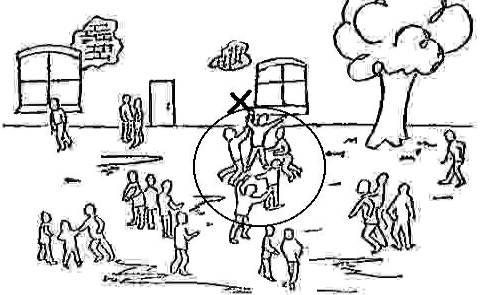
If the child (marked with a cross) places himself in the center of interaction (the informative field is circled in Fig. 1) and explains his position with some active text (for example, “I teach them how to play”, etc.), then he receives positive signs (+) simultaneously on scale No. 9 "Sociability" and on scale No. 10 "Dominance, leadership". If the child accompanies his position with an active-aggressive text (for example, “It was I who started a fight, ... we are fighting”, etc.), then he receives positive signs (+) simultaneously on scale No. 9 “Sociability” and on scale No. 10 "Dominance, leadership", and scale No. 11 "Conflict, aggressiveness".
If the child places himself outside the "circle" (except for a lone figure in the upper left corner - scale No. 13 "Fenced off"), then these positions are considered uninformative and are not included in the registration sheet. Tasks 23, 24 and others are processed in a similar way. Here I would like to note that tasks 22–24, in addition to diagnosing the leadership potential of the child's personality, can also show the type of leadership (Fig. 2).
Task 23. Here are your comrades. They fight for reasons you don't know. Show or mark with a cross where you will be. Tell me what happened? 
Consider task 23 . Inside the informative field of the figure (circled), in addition to the participants in the interaction, the figures of the so-called "aggressor" and "peacemaker" (marked with arrows) are clearly distinguished. Very often, the child being examined identifies himself with one of the key figures, accompanying the choice with the appropriate text: either “I beat everyone,” or “I separate those who fight, I try to reconcile them.” He, accordingly, receives positive signs (+) at the same time both on the scale No. 9 "Sociability" and on the scale No. 10 23. Here are your comrades. They fight for reasons you don't know. Show or mark with a cross where you will be. Tell me what happened? "Domination, Leadership". By the nature of the answers, we also have the opportunity to assume the type of leadership: negative or positive. A negative leader seeks to exercise dominance through aggressive actions, a positive one through persuasion and trust.
Information about the type of leadership is of an exclusively qualitative nature and is not included in the registration list. Table 3 is given below, which indicates which scales the answer to a particular task applies to.
Table 3
| job number | No. of corresponding scales | job number | No. of corresponding scales |
| 1 | 1, 2, 3 | 22 | 9, 10, 11, 13 |
| 2 | 1, 2, 4, 5 | 23 | 9, 10, 11 |
| 3 | 1, 2, 3 | 24 | 9, 10, 11, 13 |
| 4 | 1, 2, 3, 4, 5, 6, 9 | 25 | 11, 12 |
| 5 | 2, 3, 4, 5, 6, 8 | 26 | 7, 8 |
| 6 | 3, 4 | 27 | 1 |
| 7 | 3, 5, 13 | 28 | 7, 8 |
| 8 | 1, 2, 3, 4, 5, 6, 9, 13 | 29 | 7, 8, 13 |
| 9 | 1, 2, 4, 5, 6, 7, 13 | 30 | 4, 5, 6, 7, 13 |
| 10 | 1, 2, 4, 5, 6, 13 | 31 | 8 |
| 11 | 1, 2, 4, 5, 6, 7 | 32 | 7, 8 |
| 12 | 1, 2, 4, 5, 6, 13 | 33 | 11, 12 |
| 13 | 1, 2, 3, 4, 5, 6, 7 | 34 | 6, 11, 12 |
| 14 | 1, 2, 3, 13 | 35 | 11, 12 |
| 15 | 1, 2, 4, 13 | 36 | 12 |
| 16 | 4, 13 | 37 | 2, 11, 12 |
| 17 | 1, 2, 3, 4, 5, 6, 7, 9, 13 | 38 | 1, 11, 12 |
| 18 | 1, 2, 4, 5, 6, 7, 13 | 39 | 10 |
| 19 | 1, 2, 4, 5, 6, 13 | 40 | 1, 2, 3, 4, 5, 6, 7, 13 |
| 20 | 10 | 41 | 1, 2, 3, 5, 13 |
| 21 | 10, 13 | 42 | 1, 2, 3, 4, 13 |
The use of the above table when processing the test results greatly facilitates the work of the researcher in filling out the registration sheet (profile) for the child being examined.
3.5. Step three. Analysis of the types of behavioral response of the child
Scale No. 12 "Reaction to frustration" or "Social adequacy" involves a more detailed analysis. Of the various reactions to frustration, I. N. Gilyasheva and N. D. Ignatieva recommend differentiating three when using this technique.
1. Active-aggressive reaction, in which irritation, anger, hostility splashes out on others. Answer options:
- scream,
- to laugh at someone,
- protest,
- go somewhere contrary to the ban,
- get angry
- hit
- call, beat,
- take away.
2. Passive-passive reaction, the typical manifestations of which include a return to more primitive forms of behavior (regression) and a decrease in the efficiency of activity:
- cry,
- take offense
- to complain,
- "puff up".
3. Neutral, indifferent reaction- according to the authors of the methodology, the most adequate, indicating "frustration tolerance" - the absence of frustration or resistance to the frustrator. Also in this case, we can talk not so much about a calm state, but about tension, effort, restraint of undesirable impulsive reactions:
- don't say anything
- do nothing
- to shrug,
- keep playing,
- make a remark.
I. N. Gilyasheva and N. D. Ignatieva believe that a neutral, indifferent reaction may indicate that the child has mastered the appropriate norms of behavior, is able to restrain unwanted emotional reactions, which in turn indicates his social adaptability.
In order to diagnose the type of response of the respondent, it is necessary to present scale No. 12 in the form of a table, which will include the options for the child's answers to the corresponding tasks of the methodology.
To illustrate, let's take the real answers of the respondent Sasha K. (Table 3).
Table 3
Analysis of response types according to scale No. 12 "Reaction to frustration"
As can be seen from the above example of the qualitative processing of scale No. 12, the respondent equally exhibits passive-passive and active-aggressive reactions. The reaction of "frustration tolerance", indicating the absence of frustration, is present only in task No. 38 in relation to the figure of the mother. In relation to his mother, Sasha K. demonstrates a lack of tension, obedience, while the sphere of interaction with peers seems frustrated and conflicting.
It is important to note that only those responses of the child that are neutral-indifferent in nature, i.e. reactions of "frustration tolerance", are entered on the scale No. 12 of the registration sheet with a positive sign (+). Reactions of an active-aggressive type are entered into the scale "Conflict, aggressiveness". Reactions of the passive-passive type are not recorded in the registration sheet.
In this connection Special attention I would like to devote to task No. 35 from the “Reaction to frustration” scale, where the child is asked to find a way out of the obstacle situation:
A friend took your pen without permission.
- What will you do?
- Cry?
- To complain?
- Are you trying to pick?
- Will you start hitting him?
In the methodology, this situation is controversial, because the list options answers in this task does not imply a neutral-indifferent (socially adequate) answer.
After analyzing the children's answers, we came to the conclusion that in most cases (77 out of 100) children answer "select", and gender differences in the choice of answer were also not established. The reaction “I will try to take it away” was chosen by 39 boys and 38 girls. This fact makes it possible to assume that the “take away” reaction can be considered socially normative for a given age, despite the fact that this reaction is of an actively aggressive nature. Therefore, the respondent child who chose the option “I will try to select” as an answer to task No. 35 receives a positive sign (+) in the registration sheet both on scale No. 12 “Reaction to frustration” and on scale No. 11 “Conflict, aggressiveness”.
Thus, the quantitative processing of data on the scale No. 12 "Reaction to frustration" involves the preliminary compilation of a table of types of response, and only after that - registration in the "profile". An example is provided in the appendix. 3.
Bibliography:
- Almanac of psychological tests - M .: Publishing House of KSP, 1996. - 400s
- Andreeva G.M. Social Psychology. - M .: Aspect Press, 1997. - 376s
- Bleikher V.M., Kruk I.V., Bokov S.N. Practical pathopsychology: A guide for physicians and medical psychologists. - Rostov-n / D .: Phoenix, 1996. - 448s
- Bodalev A.A. On the relationship of communication and relationships // Vopr. psychology. 1994. No. 1. - S. 122-126.
- Bodalev A.A. Psychology of interpersonal relations (to the 100th anniversary of the birth of V. N. Myasishchev) // Vopr. psychology. 1993. No. 2. - S. 89–91.
- Baranova O.M. Additional features of the technique "Family Drawing" // School psychologist. 2001. No. 29. - S. 3-7.
- Burlachuk L.F., Morozov S.M. Dictionary-reference book on psychodiagnostics. - St. Petersburg: Peter, 2000. - 528s
- Venger A.L., Zuckerman G.A. Scheme of individual examination of children of primary school age. - Tomsk: Peleng, 1993. - 69s
- Gilyasheva I.P., Ignatieva N.D. Methodology for the study of interpersonal relations of the child: Method. allowance. Issue. 7. - M.: Folium, 1994. - 64s
- Kagan M.S. The world of communication: The problem of intersubjective relations. - M.: Politizdat, 1988. - 319s
- Levitov V.N. Frustration as one of the types of mental states // Vopr. psychology. 1967. No. 6. – pp. 118–129
- Lisina M.I. Communication with adults in children of the first seven years of life // Reader in developmental psychology. - M .: Thought, 1994. - 367 p.
- Lubovsky D.V. On the application of the test of pictorial frustration by S. Rosenzweig in school psychodiagnostics // Vopr. Psychology 1990. No. 3. - P. 151–154
- Makarets A.A. Possibilities of using the "Film-test" technique by R. Gilles for children of primary school age: Degree work. - Vladivostok, 2001.
- Myasishchev V.N. Psychology of relations. - M .: Publishing house "Institute of Practical Psychology", 1995. - 356s
- General psychodiagnostics / Ed. A.A. Bodaleva, V.V. Stolin. - M.: Publishing House of Moscow State University, 1987. - 305s
- Osnitsky A.K. Identification of the problems of the child and parents with the help of "Film-test" by R. Gilles // Vopr. psychology. 1997. No. 1.– P. 18–19c
- Parygin B.D. Fundamentals of socio-psychological theory. - M.: Thought, 1971. - 347 p.
- Psychological Dictionary / Ed. A.V. Petrovsky, M.G. Yaroshevsky. - 2nd ed. - M .: Politizdat, 1990. - 494s
- Romanova E.S., Potemkina O.F. Graphic methods in psychological diagnostics. - M.: Didakt, 1992. - 256s
- Rubinshtein S.L. Basics general psychology: In 2 vols. Vol. II. – M.: Pedagogy, 1989. – 327p.
- Smirnova E.O. Formation of interpersonal relations in early ontogenesis // Vopr. psychology. 1994. No. 6. - S. 5–15
- Vocabulary practical psychologist/ Comp. S.Yu. Golovin. - Minsk.: Harvest, 1997. - 800s
- Modern Psychology: A Reference Guide. - M.: INFRA-M, 1999. - 668s
- Elkonin D.B. Mental development in childhood. - M .: Publishing house "Institute of Practical Psychology", 1995. - 416s
Rene Gilles technique.
This projective technique is used to study the interpersonal relations of the child, his social fitness and relationships with others.
The technique is visual-verbal, consists of 42 pictures depicting children or children and adults, as well as text tasks. Its focus is to identify the characteristics of behavior in a variety of life situations that are important for the child and affect his relationship with other people.
Before starting work with the technique, the child is informed that they are expected to answer questions from the pictures. The child looks at the pictures, listens or reads the questions and answers.
The child must choose a place for himself among the depicted people or identify himself with a character occupying a particular place in the group. He can choose to be closer or further away from a certain person. In text tasks, the child is asked to choose a typical form of behavior, and some tasks are built according to the sociometric type.
Thus, the technique allows obtaining information about the child's attitude to various people around him (to the family environment) and phenomena.
Simplicity and schematicity, which distinguish the R. Gilles method from other projective tests, not only make it easier for the child being tested, but also make it possible to formalize and quantify it relatively more. In addition to a qualitative assessment of the results, this projective technique of interpersonal relations allows us to present the results of a psychological examination in terms of a number of variables and quantitatively.
The psychological material that characterizes the system of interpersonal relations of a child can be conditionally divided into two large groups of variables.
1. Variables that characterize the specific personal relationships of the child: attitude to the family environment (mother, father, grandmother, sister, etc.), attitude to a friend or girlfriend, to an authoritative adult, etc.
2. Variables that characterize the child himself and manifest themselves in various ways: sociability, isolation, striving for dominance, social adequacy of behavior.
In total, the authors who adapted the methodology identify 12 features:
relation to mother
relation to father
attitude towards mother and father as a family couple,
relationship with brothers and sisters
relationship with grandparents
relationship with a friend
relationship with the teacher
curiosity, desire for dominance,
sociability, isolation, adequacy.
Attitude towards a certain person is expressed by the number of choices of this person, based on the maximum number of tasks aimed at identifying the corresponding attitude.
The method of R. Gilles cannot be classified as purely projective, it is a form that is transitional between the questionnaire and projective tests. This is her great advantage. It can be used as a tool for in-depth study of personality, as well as in studies requiring measurements and statistical processing.
The key to the René Gilles technique
Stimulus material for the method of Rene Gilles.
1. Here is the table at which they sit different people. Mark with a cross where you sit.
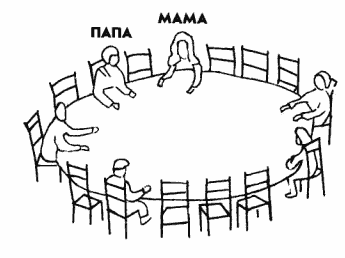
2.
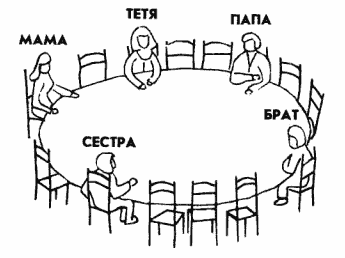
3. Mark with a cross where you sit.
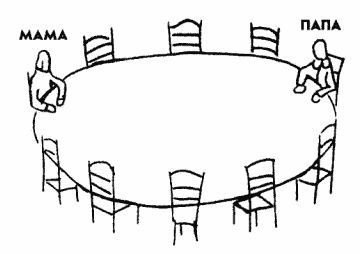
4. Now place a few people and yourself around this table. Designate their family relations (father, mother, brother, sister) or friend, comrade, classmate.

5. Here is a table at the head of which sits a man whom you know well. Where would you sit? Who is this person?
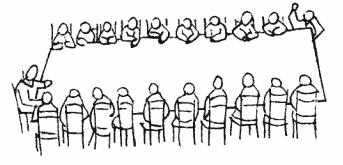
6. You and your family will spend your holidays with the owners who have a big house. Your family has already occupied several rooms. Choose a room for yourself.

7. You have been visiting friends for a long time. Mark with a cross the room that you would choose (choose).

8. Once again with friends. Designate some people's rooms and your room.

9. Decided to give one person a surprise.
Do you want them to do it?
To whom?
Or maybe you don't care?
Write below.
10. You have the opportunity to leave for a few days to rest, but where you are going, there are only two free places: one for you, the second for another person. Who would you take with you?
Write below.
11. You have lost something that is very valuable. Who will you tell about this trouble first?
Write below.
12. Your teeth hurt and you have to go to the dentist to have the bad tooth pulled out.
Will you go alone?
Or with someone?
If you go with someone, who is that person?
Write below.
13. You passed the exam. Who will you tell about it first?
Write below.
14. You are on a walk outside the city. Mark with a cross where you are.

15. Another walk. Mark where you are this time.
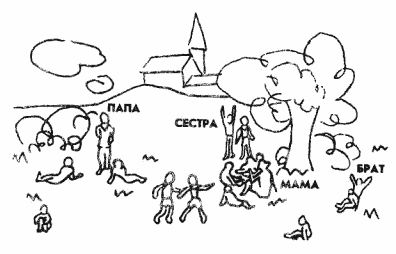
16. Where are you this time?
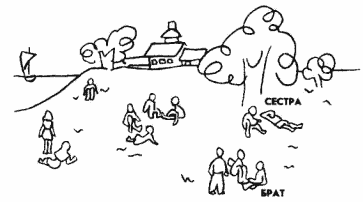
17. Now place yourself and a few people on this drawing. Draw or mark with crosses. Sign what kind of people they are.
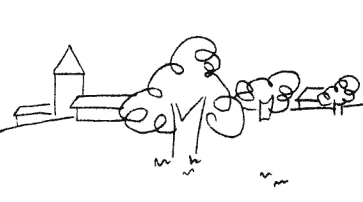
18. You and some others were given gifts. Someone received a gift much better than others. Who would you like to see in his place? Or maybe you don't care? Write.
19. You are going on a long journey, you are going far from your relatives. Who would you miss the most? Write below.
20. Here are your comrades going for a walk. Mark with a cross where you are going.
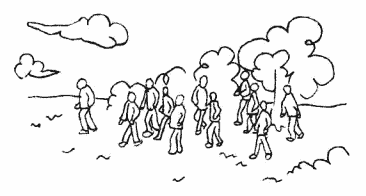
21. Who do you like to play with?
with friends your age
younger than you
older than you
Underline one of the possible answers.
22. This is a playground. Designate where you are.

23. Here are your comrades. They fight for reasons you don't know. Mark with a cross where you will be.
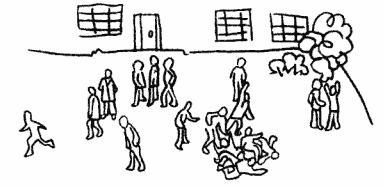
24. These are your comrades quarreling over the rules of the game. Mark where you are.
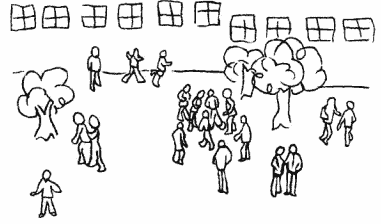
25. A friend deliberately pushed you and knocked you off your feet. What will you do?
Will you cry?
Complain to the teacher?
Will you hit him?
Will you notice him?
Won't you say anything?
Underline one of the answers.
26. Here is a man you know well. He says something to those sitting on the chairs. You are among them. Mark with a cross where you are.

27. Do you help your mother a lot?
Few?
Seldom?
Underline one of the answers.
28. These people are standing around the table, and one of them is explaining something. You are among those who listen. Mark where you are.

29. You and your comrades are on a walk, one woman is explaining something to you. Mark with a cross where you are.
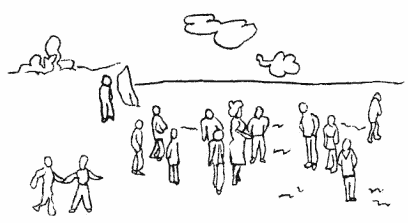
30.During the walk, everyone settled down on the grass. Designate where you are.
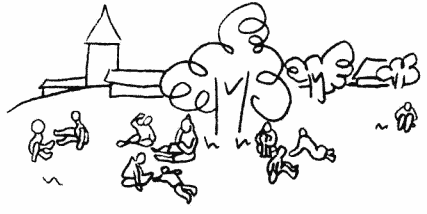
31. These are people who are watching an interesting performance. Mark with a cross where you are.
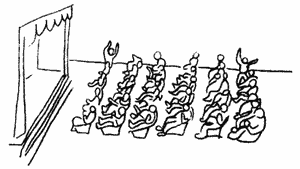
32. This is a table view. Mark with a cross where you are.
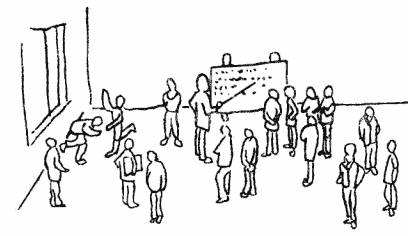
33. One of your comrades laughs at you. What will you do?
Will you cry?
Will you shrug your shoulders?
Will you call him names, beat him?
Underline one of the answers.
34. One of the comrades laughs at your friend. What will you do?
Will you cry?
Will you shrug your shoulders?
Will you laugh at him?
Will you call him names, beat him?
Underline one of the answers.
35. A friend took your pen without permission. What will you do?
Cry?
To complain?
Scream?
Are you trying to pick?
Will you start hitting him?
Underline one of the answers.
36. You play loto (or checkers or some other game) and lose twice in a row. You're not happy? What will you do?
Underline one of the answers.
37. Your father doesn't let you go out. What will you do?
Will you answer anything?
Are you puffed up?
Will you start crying?
Will you protest?
Underline one of the answers.
38. Mom doesn't let you go for a walk. What will you do?
Will you answer anything?
Are you puffed up?
Will you start crying?
Will you protest?
Will you try to go against the ban?
Underline one of the answers.
39. The teacher came out and entrusted you with the supervision of the class. Are you capable of completing this assignment?
Write below.
40. You went to the cinema with your family. The cinema has a lot of empty seats. Where will you sit? Where will those who came with you sit?
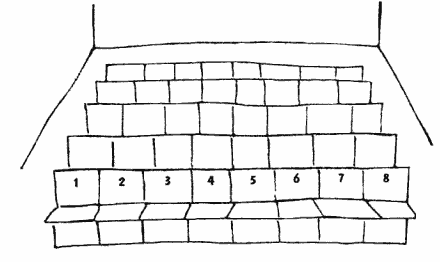
41. There are many empty seats in the cinema. Your relatives have already taken their places. Mark with a cross where you sit.
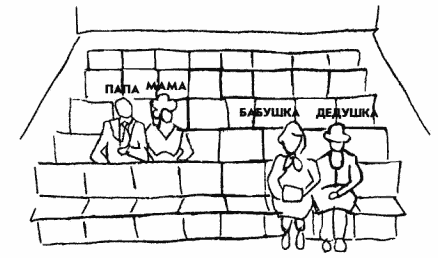
42. Again at the cinema. Where will you sit?
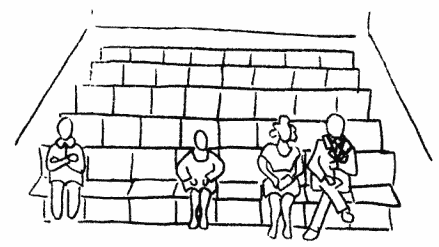
Methods for studying motivation (according to N. L. Belopolskaya).
As a model for determining the dominance of educational or game motives of behavior, it is proposed to use the introduction of one or another motive in conditions of mental satiety. In this case, the objective indicators of the change in activity will be the quality and duration of the task, which, before the introduction of the motive under study, caused a state of mental satiety in the child.
Drawing circles can be used as experimental material in the experiment on mental satiety. The learning motive is that the subject is told that now he will learn to write the letter "O" (or the number "0") beautifully. If he wants to get the highest mark for his work - "5", then he must write beautifully at least 1 page.
The game motif may be as follows. Figures of a hare and a wolf are placed in front of the child (you can use images of these animals instead of figures). The subject is offered to play a game in which the hare needs to hide from the wolf so that he does not eat it. The child can help the hare by drawing a large field for him with even rows of cabbages. The field will be a sheet of white paper, and the cabbage will be represented by circles. The rows of cabbage in the field should be even and frequent, and the cabbages themselves should be of the same size, then the hare will be able to hide among them from the wolf. For example, the experimenter draws the first two rows of cabbage, then the child continues to work independently.
Depending on in which case (first or second) the quality of drawing circles and the duration of the task will be better and longer, the child is dominated by either an educational or a game motive for activity.
Methodology "Kinetic pattern of the family" (KRS).
Description of the test.
The test "Kinetic pattern of the family" is aimed not so much at identifying certain personality anomalies, but at predicting an individual style of behavior, experience and affective response in significant and conflict situations, identifying unconscious aspects of personality.
The experimental procedure is as follows:
For the study, you need a sheet of white paper (21x29 cm), six colored pencils (black, red, blue, green, yellow, brown), an eraser.
Test subject instructions.
"Please draw your family". In no case should one explain what the word "family" means, since this distorts the very essence of the study. If child asks what to draw, the psychologist should simply repeat the instructions.
The duration of the task is not limited (in most cases it lasts no more than 35 minutes). When performing the task, it should be noted in the protocol:
a) the sequence of drawing details;
b) pauses for more than 15 seconds;
c) erasing details:
d) spontaneous comments of the child;
e) emotional reactions to their connection with the depicted content.
After completing the task, one should strive to get as much information as possible verbally. The following questions are usually asked:
1. Tell me, who's pictured here?
2. Where are they located?
3. What are they doing?
4. Are they fun or bored? Why?
5. Which of the drawn people is the happiest? Why?
6. Who is the most unfortunate among them? Why?
The last two questions provoke the child to openly discuss feelings, which not every child is inclined to do.
Therefore, if the child does not answer them or answers formally, you should not insist on an answer. During the interview, the psychologist should try to find out the meaning of what the child has drawn: feelings for individual family members; why the child did not draw one of the family members (if this happened); what certain details of the picture mean for the child (birds, animals).
At the same time, if possible, direct questions should be avoided, insisting on an answer, as this can induce anxiety, defensive reactions. Projective questions often turn out to be productive, for example: “If a person were drawn instead of a bird, then who would it be?”, “Who would win in the competition between your brother and you?”, “Whom will mom invite to go with her?” etc.
1. Imagine that you have two tickets to the circus. Who would you invite to come with you?
2. Imagine that your whole family is visiting, but one of you is sick and has to stay at home. Who is he?
3. You build a house from the designer (cut out paper dress for a doll) and you're out of luck. Who will you call for help?
4. You have "N" tickets (one less than family members) to an interesting movie. Who will stay at home?
5. Imagine that you are stranded on a deserted island. Who would you like to live there with?
6. You received an interesting lotto as a gift. The whole family began to play, but you are one person more than necessary. Who won't play?
To interpret, you also need to know:
A) the age of the child under study;
b) the composition of his family, the age of his brothers, sisters;
c) if possible, have information about the behavior of the child in the family, kindergarten or school.
Interpretation of the results of the "Family Drawing" test.
The interpretation of the drawing is conditionally divided into 3 parts:
1) analysis of the structure "Figure of the family";
2) interpretation of the features of graphic images of family members;
3) analysis of the drawing process.
1. Analysis of the structure of the "Family Drawing" and comparison of the composition of the drawn and real family.
A child experiencing emotional well-being in a family is expected to draw a complete family.
The distortion of the real composition of the family always deserves close attention, since behind this there is almost always an emotional conflict, dissatisfaction with the family situation.
The extreme options are drawings in which:
a) people are not depicted at all;
b) only people not related to the family are depicted.
Most of the time these reactions are:
a) traumatic experiences related to the family;
b) a feeling of rejection, abandonment;
c) autism (that is, psychological alienation, expressed in the child's withdrawal from contact with the surrounding reality and immersion in the world of his own experiences);
d) a sense of insecurity, a high level of anxiety;
e) poor contact between the psychologist and the child under study.
Children reduce the composition of the family, "forgetting" to draw those family members who are less emotionally attractive to them, with whom conflict situations have developed. By not drawing them, the child, as it were, avoids negative emotions associated with certain people.
Most often there are no brothers or sisters in the picture, which is associated with situations of competition observed in families. The child, thus, in a symbolic situation "monopolizes" the missing love and attention of parents to him.
In some cases, instead of real family members, the child draws small animals, birds. The psychologist should always clarify with whom the child identifies them. Most often, brothers or sisters are drawn in this way, whose influence in the family the child seeks to reduce, devalue and show symbolic aggression towards them.
If in the drawings the child does not draw himself, or instead of the family he draws only himself, then this also indicates violations of emotional communication.
In both cases, the painter does not include himself in the family, which indicates a lack of a sense of community. The absence of "I" in the picture is more typical for children who feel rejection, rejection.
The presentation in the figure of only "I" can indicate different psychological content depending on other characteristics.
If in the image of "I" a large number of details of the body, colors, decoration of clothes, a large size of the figure, then this indicates a certain egocentricity, hysterical character traits.
If the self-drawing is characterized by a small size, sketchiness, a negative background is created by the color scheme, then we can assume the presence of a feeling of rejection, abandonment, sometimes - autistic tendencies.
An increase in the composition of the family, the inclusion of strangers in the drawing of the family can also be informative. As a rule, this is due to the unsatisfied psychological needs of the only children in the family, the desire to take a guarded, parental, leading position in relation to other children (drawn dogs, cats, etc., can give the same information in addition to family members).
In addition to the parents (or instead of them), the adults drawn, who are not related to the family, indicate the perception of the negativity of the family, the search for a person who can satisfy the child in close emotional contacts, or the consequence of a feeling of rejection, uselessness in the family.
2. Location of family members.
It indicates some psychological features of relationships in the family. The analysis makes it necessary to distinguish what the drawing reflects - subjectively real, desired, or what the child is afraid of, avoids.
Family cohesion, drawing a family with joined hands, uniting them in general activities are indicators of psychological well-being. Drawings with opposite characteristics (disunity of family members) may indicate a low level of emotional ties.
The close arrangement of the figures, due to the idea to place family members in a limited space (a boat, a small house, etc.), may indicate the child’s attempt to unite, unite the family (for this purpose, the child resorts to external circumstances, because he feels the futility of such attempts).
In the drawings, where part of the family is located in one group, and one or more persons are distant, this indicates a feeling of exclusion, alienation. In the case of the alienation of one family member, one can assume a negative attitude of the child towards him, sometimes judge the threat emanating from him.
3. Analysis of the features of the drawn figures.
The features of graphic drawing of individual family members can provide information of a wide range: about the emotional attitude of the child to an individual family member, about how the child perceives him, about the "I-image" of the child, about his gender identity, etc.
When assessing the emotional relationship of the child to family members, attention should be paid to:
1) the number of body parts. Are: head, hair, ears, eyes, pupils, eyelashes, eyebrows, nose, mouth, neck, shoulders, arms, palms, fingers, nails, feet;
2) decoration (details of clothing and decorations): hat, collar, tie, bows, pockets, hairstyle elements, patterns and trim on clothes;
3) the number of colors used to draw the figure.
A good emotional relationship with a person is accompanied by a large number of body parts, decoration, and the use of various colors.
Great sketchiness, incompleteness of the drawing, omission of essential parts of the body (head, arms, legs) can indicate, along with a negative attitude towards a person, also aggressive impulses towards him.
Children, as a rule, draw the largest father and mother, which corresponds to reality.
Some children draw themselves as the largest or equal in size to their parents. It's connected with:
a) the child's egocentricity;
b) competition for parental love, excluding or reducing the "competitor".
Significantly smaller than other family members, children draw themselves who:
a) feel their insignificance, uselessness;
b) requiring guardianship, care from parents.
The absolute value of the figures can also be informative. Large, full-page figures are drawn by impulsive, self-confident, dominating children. Very small figures are associated with anxiety, a sense of danger.
When analyzing, you should pay attention to drawing individual parts of the body:
1. Hands are the main means of influencing the world, of physically controlling the behavior of other people.
If a child draws himself with his arms raised up, long fingers, then this is often associated with aggressive desires.
Sometimes such drawings are drawn by outwardly calm and complaisant children. It can be assumed that the child feels hostility towards others, but his aggressive impulses are suppressed. Such self-drawing may also indicate the child's desire to compensate for his weakness, the desire to be strong, to dominate others. This interpretation is more reliable when, in addition to "aggressive" arms, the child also draws broad shoulders or other attributes of "masculinity" and strength.
Sometimes a child draws all family members with hands, but "forgets" to draw them for himself. If at the same time the child also draws himself disproportionately small, then this may be due to a feeling of powerlessness, his own insignificance in the family, with the feeling that others suppress his activity, overly control him.
2. Head- center of localization "I", intellectual activity; The face is an important part of the body in the process of communication.
If parts of the face (eyes, mouth) are missing in the drawing, this may indicate serious communication disorders, isolation, autism. If, when drawing other family members, the child skips the head, facial features, or strokes the entire face, then this is often associated with a conflict relationship with this person, a hostile attitude towards him.
The facial expressions of the painted people can also be an indicator of the child's feelings for them. However, children tend to draw smiling people, this is a kind of "stamp" in the drawings, but this does not mean at all that children perceive others in this way. For the interpretation of a family drawing, facial expressions are significant only in cases where they differ from each other.
Girls pay more attention to face drawing than boys, this indicates a good gender identity girls.
In the drawings of girls, this moment may be associated with concern for their physical beauty, the desire to compensate for their physical shortcomings, and the formation of stereotypes of female behavior.
Presentation of the teeth and prominence of the mouth are common in children prone to oral aggression. If a child draws not himself, but another family member in this way, then this is often associated with a feeling of fear, the perceived hostility of this person to the child.
Each adult is characterized by certain details in the drawing of a person, which are enriched with age, and their omission in the drawing, as a rule, is associated with the denial of some functions, with conflict.
In children's drawings, two different schemes for drawing individuals of different genders are distinguished. For example, a man's torso is drawn in an oval shape, a woman's is triangular.
If a child draws himself in the same way as other figures of the same sex, then we can talk about adequate gender identification. Similar details and colors in the presentation of two figures, for example, a son and a father, can be interpreted as the son's desire to be like his father, identification with him, good emotional contacts.
4. Analysis of the drawing process.
When analyzing the drawing process, you should pay attention to:
a) the sequence of drawing family members;
b) the sequence of drawing details;
c) erasure;
d) return to already drawn objects, details, figures;
e) pauses;
e) spontaneous comments.
The interpretation of the drawing process in general implements the thesis that behind the dynamic characteristics of drawing lie changes in thought, actualization of feelings, tension, conflicts, they reflect the significance of certain details of a child's drawing.
In the drawing, the child first depicts the most significant, main or most emotional loved one. Often the mother or father is drawn first. The fact that children are often the first to draw themselves is probably due to their egocentrism as an age characteristic. If the first child draws not himself, not his parents, but other family members, then these are the most emotionally significant faces for him.
There are cases when the child is the last to draw the mother. Often this is associated with a negative attitude towards her.
If the first figure drawn is carefully drawn and decorated, then one can think that this is the most beloved member of the family, whom the child reveres and wants to be like.
Some children first draw various objects, the base line, the sun, furniture, etc. and only in the last place they start depicting people. There is reason to believe that such a sequence in the performance of a task is a kind of defense, with the help of which the child pushes back an unpleasant task in time. Most often this is observed in children with a dysfunctional family situation, but it can also be a consequence of poor contact between the child and the psychologist.
The return to drawing the same family members, objects, details indicates their significance for the child.
Pauses before drawing certain details, family members are most often associated with a conflicting attitude and are an external manifestation of an internal dissonance of motives. At an unconscious level, the child, as it were, decides whether or not to draw a person or a detail associated with negative emotions.
Erasing the drawn, redrawing can be associated with both negative emotions in relation to the drawn family member, and with positive ones. The final result of the drawing is decisive.
Spontaneous comments often clarify the meaning of the child's content being drawn. Therefore, they must be listened to carefully. Their appearance betrays the most emotionally "charged" places in the drawing. This can help guide both post-drawing questions and the interpretation process itself.
To study the sphere of interpersonal relations of the child and his perception of intra-family relations, the children's projective technique of René Gilles is intended. The purpose of the methodology is to study the social adaptability of the child, as well as his relationship with others.
The technique is visual-verbal, consists of 42 pictures depicting children or children and adults, as well as text tasks. Its focus is to identify the characteristics of behavior in a variety of life situations that are important for the child and affect his relationship with other people.
Before starting work with the technique, the child is informed that they are expected to answer questions from the pictures. The child looks at the pictures, listens or reads the questions and answers. The child must choose a place for himself among the depicted people, or identify himself with a character occupying a particular place in the group. He can choose to be closer or further away from a certain person. In text tasks, the child is asked to choose a typical form of behavior. Thus, the technique allows obtaining information about the child's attitude to various people around him (to the family environment) and phenomena.
Simplicity and schematicity, which distinguish the method of R. Gilles from other projective tests, not only make it easier for the child under test, but make it possible to formalize it relatively more. In addition to a qualitative assessment of the results, the children's projective method of interpersonal relations allows us to present the results of a psychological examination in terms of a number of variables and quantitatively.
The technique can be used when examining children 4 to 12 years old, and in case of pronounced infantilism and delay mental development- and older.
The psychological material that characterizes the system of personal relations of the child, obtained with the help of the methodology, can be divided into two large groups of variables:
1. Variables that characterize the specific personal relationships of the child with other people:
- attitude towards the mother;
- relation to the father;
- attitude towards mother and father, perceived by the child as a parental couple (parents);
- attitude towards brothers and sisters;
- attitude towards grandparents and other close adult relatives;
- attitude towards a friend (girlfriend);
- attitude towards the teacher.
- curiosity;
- the desire to communicate in large groups of children;
- striving for dominance, leadership in groups of children;
- conflict, aggressiveness;
- reaction to frustration;
- desire for privacy.
test material
1. Here is a table at which different people are sitting. Mark with a cross where you sit.
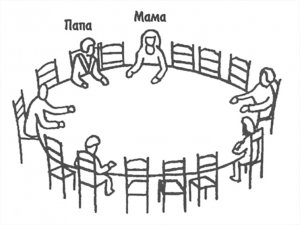
2. Mark with a cross where you will sit.
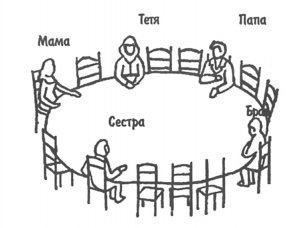
3. Mark with a cross where you will sit.
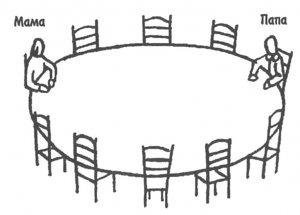
4. Now place a few people and yourself around this table. Indicate their relationship (father, mother, brother, sister) or (friend, comrade, classmate).
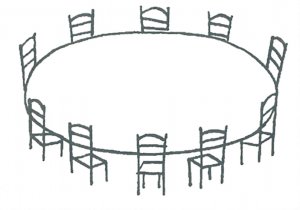
5. Here is a table at the head of which sits a man whom you know well. Where would you sit? Who is this person?
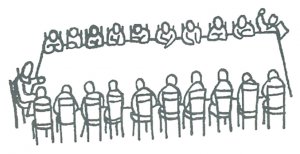
6. You and your family will spend your holidays with the owners who have a big house. Your family has already occupied several rooms. Choose a room for yourself.
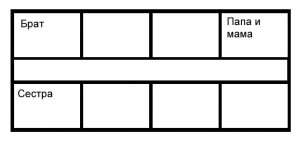
7. You stay with friends for a long time. Mark with a cross the room that you would choose (choose).
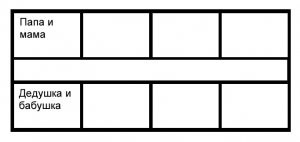
8. Once again with friends. Designate some people's rooms and your room.
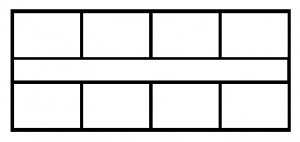
9. It was decided to give one person a surprise. Do you want them to do it? To whom? Or maybe you don't care? Write below.
10. You have the opportunity to leave for a few days to rest, but where you are going, there are only two free places: one for you, the second for another person. Who would you take with you? Write below.
11. You have lost something that is very expensive. Who will you tell about this trouble first? Write below.
12. Your teeth hurt and you have to go to the dentist to have the bad tooth pulled out. Will you go alone? Or with someone? If you go with someone, who is that person? Write.
13. You passed the exam. Who will you tell about it first? Write below.
14. You are on a walk outside the city. Mark with a cross where you are.
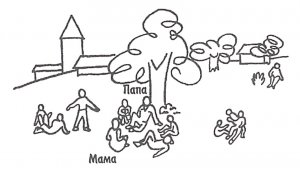
15. Another walk. Mark where you are this time.
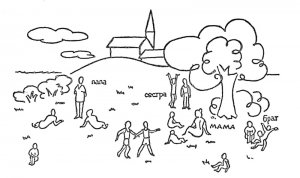
16. Where are you this time?
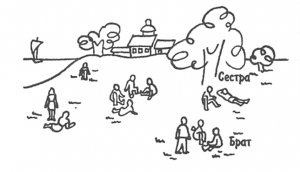
17. Now place a few people and yourself in this drawing. Draw or mark with crosses. Sign what kind of people they are.
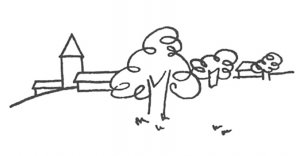
18. You and some others were given gifts. Someone received a gift much better than others. Who would you like to see in his place? Or maybe you don't care? Write.
19. You are going on a long journey, you are going far from your relatives. Who would you miss the most? Write below.
20. Here are your comrades going for a walk. Mark with a cross where you are.
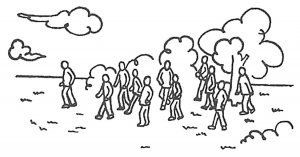
21. Whom do you like to play with: with comrades of your age; younger than you older than you? Underline one of the possible answers.
22. This is a playground. Designate where you are.
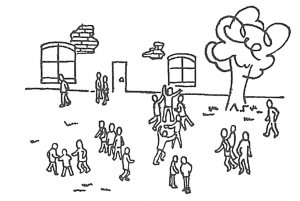
23. Here are your comrades. They fight for reasons you don't know. Mark with a cross where you will be.
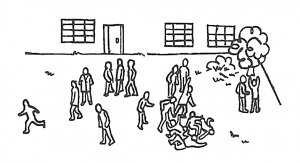
24. These are your comrades quarreling over the rules of the game. Mark where you are.
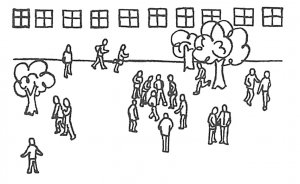
25. A friend deliberately pushed you and knocked you down. What will you do: you will cry; Complain to the teacher hit him; make a remark to him; won't you say anything? Underline one of the answers.
26. Here is a man well known to you. He says something to those sitting on the chairs. You are among them. Mark with a cross where you are.
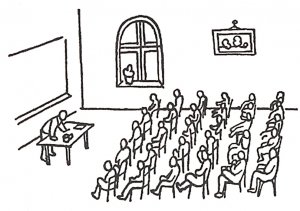
27. Do you help your mother a lot? Few? Seldom? Underline one of the answers.
28. These people are standing around the table, and one of them is explaining something. You are among those who listen. Mark where you are.
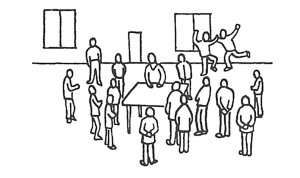
29. You and your comrades are on a walk, one woman explains something to you. Mark with a cross where you are.
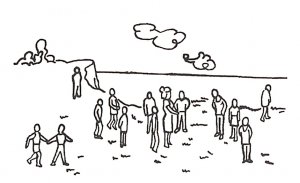
30. During the walk, everyone settled down on the grass. Designate where you are.
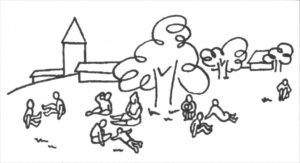
31. These are people who watch an interesting performance. Mark with a cross where you are.
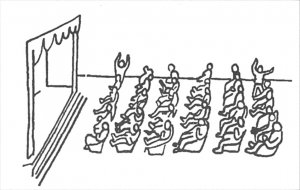
32. This is a display at the table. Mark with a cross where you are.
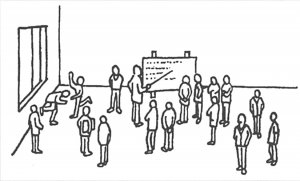
33. One of the comrades laughs at you. What will you do: you will cry; shrug your shoulders; you yourself will laugh at him; will you call him names, beat him? Underline one of these answers.
34. One of the comrades laughs at your friend. What will you do: you will cry; shrug your shoulders; you yourself will laugh at him; will you call him names, beat him? Underline one of these answers.
35. A friend took your pen without permission. What will you do: cry; to complain; scream; try to take away start hitting him? Underline one of these answers.
36. You play loto (or checkers or some other game) and lose twice in a row. You're not happy? What will you do: cry; keep playing; don't say anything; will you get angry? Underline one of these answers.
37. Father does not allow you to go for a walk. What will you do: you will not answer anything; puff up; start crying; protest; will you try to go against the ban? Underline one of these answers.
38. Mom does not allow you to go for a walk. What will you do: you will not answer anything; puff up; start crying; protest; will you try to go against the ban? Underline one of these answers.
39. The teacher came out and entrusted you with the supervision of the class. Are you capable of completing this assignment? Write below.
40. You went to the cinema with your family. The cinema has a lot of empty seats. Where will you sit? Where will those who came with you sit?
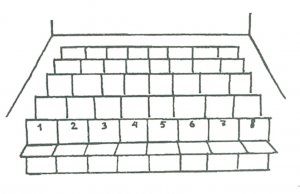
41. There are a lot of empty seats in the cinema. Your relatives have already taken their places. Mark with a cross where you sit.
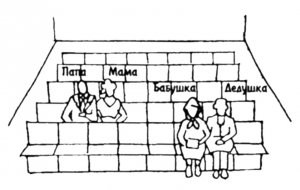
42. Again at the cinema. Where will you sit?
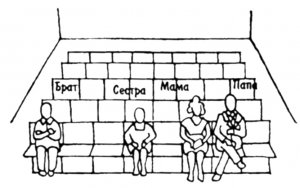
Key to the test
Each of the 13 variables forms an independent scale. The table, which presents all the scales, also indicates the number of tasks of the methodology related to one or another scale (for example, in scale No. 1 - “attitude to the mother” - there are 20 of them) and the numbers of these tasks.
| Scale name | Job numbers | Number of tasks |
|---|---|---|
| Attitude towards mother | 1-4, 8-15, 17-19, 27, 38, 40-42 | 20 |
| Attitude towards father | 1-5, 8-15, 17-19, 37, 40-42 | 20 |
| Attitude towards mother and father together, perceived by the child as a parental couple ("parents") | 1, 3, 4, 6-8, 13-14, 17, 40-42 | 12 |
| Attitude towards brothers and sisters | 2, 4-6, 8-13, 15-19, 30, 40, 42 | 18 |
| Relationship with grandparents and other close relatives | 2, 4, 5, 7-13, 17-19, 30, 40, 41 | 16 |
| Relationship with a friend | 4, 5, 8-13, 17-19, 30, 34, 40 | 14 |
| Attitude towards the teacher | 5, 9, 11, 13, 17, 18, 26, 28-30, 32, 40 | 12 |
| Curiosity | 5, 26, 28, 29, 31, 32 | 6 |
| The desire to communicate in large groups of children ("sociability in a group of children") | 4, 8, 17, 20, 22-24, 40 | 8 |
| Striving for dominance or leadership in a group of children | 20-24, 39 | 6 |
| conflict, aggression | 22-25, 33-35, 37, 38 | 9 |
| Response to frustration | 25, 33-38 | 7 |
| The desire for solitude, isolation | 7-10, 14-19, 21, 22, 24, 30, 40-42 | 18 |
The Rene Gilles technique was developed in the late 50s of the last century and allows you to test children from 4 to 12 years old for a variety of indicators. This is a great opportunity to explore the social orientation of the child, and his relationship to the family, and even to characterize his behavior. In addition, the projective technique of Rene Gilles allows you to get such deep information, the use of which will allow you to influence the child's attitude to something.
Rene Gilles technique - description
In total, there are 42 tasks in the methodology, among which more than half are with pictures. The child must answer questions, choose a place for himself in the picture, or decide on his behavior in a given situation. During the test, you can additionally ask the child questions to clarify his point of view.
As a result of the test, the child's attitude towards parents, brothers, sisters, other relatives, educator, as well as various traits - sociability, curiosity, the desire for dominance and the desire for domination will be revealed.
Rene Gilles technique - test
Speak slowly, without rushing. If the child is already reading, you can invite him to read the questions on his own.
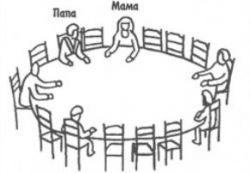
Rene Gilles technique - processing results
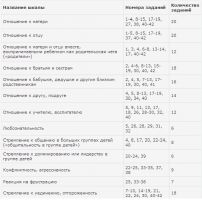
To interpret the technique of Rene Gilles, you should refer to the table. There are marked 13 variables, each of which is a separate scale. Each of the 13 variables forms an independent scale. The table shows all the scales, as well as the numbers of tasks that characterize a particular area of a child's life.
Processing René Gilles technique is quite simple. If the child indicates that he sits next to his mother at the table, you need to put a tick on the scale of attitude towards the mother, but if he chooses one of the other relatives, then a tick is put in front of him accordingly. As for his friends and range of interests, the interpretation here is similar. As a result, you need to compare the number of questions and the number of checkmarks in the answer sheet and, based on this, evaluate one or another property of the child.
One of the types of decoration is the creation of a bas-relief. The bas-relief is three-dimensional images on the walls. Flowers, images of animals and various patterns can act as bas-relief drawings.
Drawing a bas-relief image on walls and ceilings requires the ability to apply drawings on surfaces, followed by the imposition of volumetric molding on them.
To create a three-dimensional drawing, the first step is to level the wall. For this purpose, drywall sheets must be laid over the entire area that has an uneven surface. In this case, a profile frame is made on which the sheets will be installed. Thus, with the help of a frame and drywall, a smooth wall is created.
Hobby. What it is?
Nobody knows us better than we know ourselves. At first glance, a confusing expression. But if you read it thoughtfully, then what is written is really true. Only we ourselves can give a specific and clear answer to the question: who are we in this life and what we want to achieve or achieve. Surrounding people often evaluate our actions, words, demeanor, etc. However, they cannot sign for our tastes, interests, preferences. Therefore, we ourselves determine for ourselves what we want to do in life and what interests us. For many years, human hobbies have been called in one word - hobby. This article will answer the following questions: What is a hobby? What types does it have? What is the use of a hobby?



